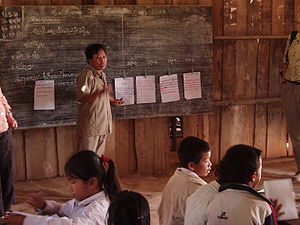Teaching Foreign Language Through Storytelling
 Patrick Henry Elementary School student teacher Isabell Pfeufer listens carefully as students edit their book reports Oct. 2. Pfeufer, who has been blind since birth, completed a three-week practicum with the class in Heidelberg, Germany, in September and October. (Photo credit: Wikipedia)
Patrick Henry Elementary School student teacher Isabell Pfeufer listens carefully as students edit their book reports Oct. 2. Pfeufer, who has been blind since birth, completed a three-week practicum with the class in Heidelberg, Germany, in September and October. (Photo credit: Wikipedia) Teacher in primary school in northern Laos (Photo credit: Wikipedia)
Teacher in primary school in northern Laos (Photo credit: Wikipedia) Students working with a teacher at Albany Senior High School, New Zealand. (Photo credit: Wikipedia)
Students working with a teacher at Albany Senior High School, New Zealand. (Photo credit: Wikipedia) Storytelling (Photo credit: cambodia4kidsorg)By Jeanette Borich
Storytelling (Photo credit: cambodia4kidsorg)By Jeanette Borich Traditionally, teachers tackle the "how" of the language. Students learn a list of vocabulary, are introduced to various rules, produce language according to those rules, and are corrected as needed.
This year I tried something different: using storytelling to help my 8th graders become more confident second-language (L2) learners. This method emphasizes the gradual acquisition of language rather than the memorization of vocabulary and rules. It's more about "what" is said than "how" it is said.
Here are my takeaways from this big change. While these insights are about teaching Spanish, they could apply to any major pedagogical shift.
Learn as much as you can about the new approach.
I explored storytelling resources that provided me with support and information about the new approach. (I'd also tried elements of this approach previously with elementary students and adults, so I drew on that experience, too.)
I learned that the formalized version of the storytelling approach—Teaching Proficiency through Reading and Storytelling (TPRS)—was developed by high school teacher Blaine Ray in the 1990s. Teachers use this approach to present new language items (lexical or grammatical). The story's narrative framework makes those items easier to grasp and remember. The philosophy of TPRS is based on effective classroom strategies as well as research in second-language acquisition.
Stories are often (but not always) created through a collaborative process involving both the teacher and the students. The stories tend to be quirky and memorable (and to give students opportunities to be inventive), which heightens engagement. Coming up with stories together helps to bind a class as a community—akin to an "inside joke," family legend, or local tradition.
The teacher explicitly discusses meanings of words and grammatical forms as the story is told—instead of asking students to memorize them beforehand as separate lists of rules and words. Grammatical explanations of new or difficult forms are interjected within the telling of the story itself. As the story develops, the teacher checks for comprehension and provides explanation as necessary.
The teacher does not expect students to produce any language until they have heard and discussed the story, understanding the L2 not as isolated vocabulary and grammatical rules but from "within" the narrative format of a story. This means that learners are more confident when they do produce language, since they have learned it in context and worked to understand its meaning.
Match your approach to the standards your students must meet.
I had experimented with storytelling when teaching Spanish to elementary school students and to adults. But I wasn't sure whether the storytelling approach could work in tandem with our middle school's standardized curriculum.
I decided to pair completion of several chapters in our traditional textbook with complementary storytelling activities. The first story I selected was one that I'd used before with adult learners. It also matched up well with the vocabulary taught in my first year Spanish course for 8th graders. Students appreciated how their own input was incorporated as the story was revealed—and I realized how important it was to select stories that engaged them.
For each story, we followed a sequence. First, small chunks of key story vocabulary were personalized with questions from students. Next, student actors dramatized the story as I revealed the storyline. Occasionally I checked comprehension with true/false statements about the stories. We also did cloze retelling activities, with students "filling in the blank."
It became clear to me that storytelling is not an extra curriculum component but a technique that can support the same standards as textbook learning. It provides an engaging way for students to use textbook vocabulary in a meaningful context.
Seek out supportive colleagues.
Whenever you're implementing a new approach, it's ideal to have a community where you can share ideas, seek and offer advice, and reflect frankly on what works and what doesn't.
I discovered a great support network in the moretprs listserv, where I've picked up valuable strategies, classroom-management ideas, and great links to practitioners' blogs. The listserv also led me to Twitter, one of the best ways to connect and find professional inspiration.
Ask students for mid-year feedback.
In January, with the help of our building instructional coach, I hosted a focus group with a group of 12 students to ask them to share their thoughts about their storytelling experiences combined with their learning from the text.
My students spoke of learning from the stories, being engaged by the stories, and retelling them. For them, understanding language in context is meaningful—none found the storytelling activities to be less valuable than the more traditional textbook-based instruction. In fact, one student said the stories helped the language seem "more real."
They did have some feedback for me on how I could adjust the course: spending more time on certain aspects of the storytelling, using the textbook mostly as a resource, and doing more whole-class story creation.
Make adjustments accordingly.
This year I have adjusted my grading practices. I now assess what students are learning in the areas of interpersonal, presentational, and interpretive communication. My colleagues and I have had valuable discussions about how our assessments should shift as our instructional techniques shift.
I'm looking forward to fine-tuning this next year, and checking in with my student focus group about whether I'm assessing in ways that match their learning experiences. I can tell you this much, though. With my new strategy, I can more easily see it in my students' eyes when they understand.
Now, more than ever, I recognize the importance of working hard to be the creative, effective teacher my students deserve. And I know from their positive feedback that storytelling is making a difference in how they think about the experience of learning a foreign language.
Have you made a big change in your instruction this year? If so, how do your takeaways match up with mine? What advice would you give to teachers who are considering a transition to a different approach?
Jeanette Borich has 30 years of experience teaching Spanish, French, and ESL to students in grades 1 through 12 as well as to adult educators. A Teacher Leaders Network member, she is the author of Fiestas de Yucatán and several action research articles. Jeanette currently teaches Spanish at Northview Middle School in Ankeny, Iowa. You can follow her on Twitter @NettieMeraMera.











Comments
Post a Comment